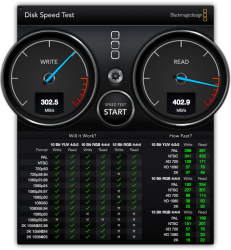...Well you are then wasting 4 drive slots to create 1 volume.
It still affords the capability.
Plus your "waste" claim illustrates that you've jumped ahead to cost:benefit without even knowing everyone's use cases.
In a case like that the loss of those slots in the new Mac Pro is a non issue, since you would have lost all of them to your single volume anyway.
Not necessarily so, because the current Mac Pro also has PCIe slots which can be provisioned.
Plus, as per Apple's OEM offerings, the storage capacity would be 2TB (or 4TB with 3rd Party offerings) and Apple's Parts Bin from which they're drawing their PCIe SSD only has a ~1TB max size. As such, we have no proof yet that there is parity in storage capacity.
Yes I know
It's related to what was said however, your remarks are more general points on why you don't like the new Mac Pro. I understand that there are things that could be problematic with the new model, but the PCIe SSD isn't one of them. That goes firmly on the plus side.
Taken utterly alone and out of context, sure, having the capability of a PCIe SSD interface is a generic "good thing". Unfortunately, there's context.
It's not, it's factually correct. The fact that internal SATA and PCIe slots are gone is not a function of the PCIe SSD,...
And there's your context.
... they could have included the SSD and still have SATA and internal card expansion intact.
But the facts are that they did not do so.
And that's why your statement was a selective half-truth: you purposefully narrowed it to remove relevant context.
Regarding subsonix's skirting of TOS policies
If it's factually incorrect point it out. If you are offended by that you should probably not engage in online forum discussions, I honestly see no offensive content in that comment.
Trying to invoke the "fact card" is a common strategy to try to hide behind the nuances of the TOS. Unfortunately, you cannot substantiate your claim. As such, you made a duplicitous statement by trying to attribute a position to another poster (me) which is untrue.
Because you could have done this because you were reacting emotionally, I was granted you a public warning. However, if you persist, then you're providing proof that your intention was malicious...and you've made the job for the Moderators a lot easier by removing ambiguity.
This is what you said.
"To dictate a specific engineering solution to meet a capability requirement is an artificial constraint and a flaw in requirements generation."
I hope you understand that the amount of times you mention a word is meaningless.
Only if one insists on ignoring context every time!

Your claim is that a solution that meets a requirement is a flaw in the requirement.
Incorrect. You've gotten the statement backwards (again?)
Once again, it is:
A requirement that dictates the solution is a flawed requirement.
Note that even if the requirement happens to dictate a solution which works, it is still a flawed requirement.
It makes no sense! Because when the specification is made, you are supposed to create a solution to meet the requirement!
I think we have different perspectives on what a "requirement" is. I'm not talking about a technical specification as a requirement, but rather a high level capability ... which frequently isn't expressed in techy terms. For example, this might be: "10% better productivity" -- and that's what then broken down to engineering specs.
To apply my above statement, a requirement of "10% better productivity by making the PC run 10% faster" is a flawed requirement because its solution dictation excludes other options from being considered ... for example, any software rewrite, OS improvements, or even workflow changes are all prohibited.
Ok so what? It has nothing to do with the new Mac Pro as you have zero insight into the design process of the machine. It's just you speculating without any facts to lean on, at all.
So it is not an indisputable fact that the new Mac Pro prototype as shown doesn't have four 3.5" bays, nor any conventional PCIe slots?
It does! In your case it may be a better fit for retro fitting a PCIe SSD in a current Mac Pro and retain booting capabilities, as well as keeping the price down.
For a new design it would be an ugly hack IMHO.
For the new MP design, the hack wouldn't be required for an SSD-based boot drive...where the new MP potentially gets 'ugly' is for those use cases where the options for increasing local storage come into play.
Yes, and I'm specifically referring to the SSD, it's clearly better! You may not like everything about the new Mac Pro, but that is besides the point.
Heaven forbid that we ever consider the product as a holistic whole.
It's a different point, that is already discussed to death in other threads, it has nothing to do with PCIe SSD or not. I'm aware of your opinion.
Actually, the "internal expansion" statements is a very good illustration for how people don't really understand their fundamental capability needs and skip ahead to specifics. This has been brought to the forefront with the nMP because it externalizes everything, which in many use cases represents a cost growth and jeopardizes the value proposition of the nMP relative to the old. To this end, ,y personal assessment, which is from a simplistic 'all other factors equal' perspective on most of the unknown tech specs, the 2013 MP has to have its retail price be roughly $600 lower than the equivalent 2012 MP in order to maintain value parity.
-hh



